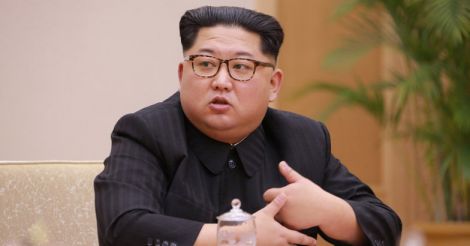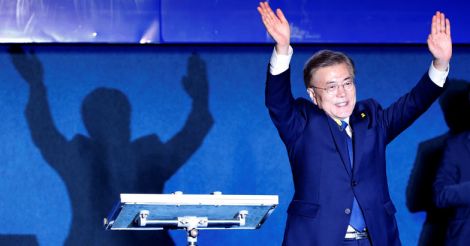Seoul: It was while waiting at the Kuala Lumpur International Airport in Malaysia after missing our connection flight to Seoul, that we met Kwang Hyun Joo. We were on our way to South Korea as president Moon Jae-in and North Korean leader Kim Jong-un are meeting in the uninhabited village of Panmunjom in the demilitarised zone between both Koreas, in a rare inter-Korea summit on April 27.
Kwang was returning from Bangkok after a business trip and looked extremely agitated as he too had missed the flight. As we started talking, it became clear that Kwang was angry not just about missing the flight. As we chatted about the political situation in Korea, especially the summit, he appeared even more angry. He was not happy that president Moon was going ahead with the peace summit. He said the legacy of the division of Korea, aggravated by the brutal Korean war, and the hostile events over the past seven decades, cannot be wished away so easily.
After reaching Seoul and talking to more people, it seems Kwang is in a minority. Most people we met were excited about the diplomatic initiatives, and were supporting president Moon. And, US president Donald Trump as well. Trump and Kim Jong-un could meet soon. And, if the inter-Korean summit is a success, the chances of the Trump-Kim meeting will seriously improve. Yet, despite the positive vibes and expectations, most people warned that the history of mistrust and division between the two Koreas had been so vicious that they were uncertain about the chances of peace. A group of young backpackers whom we met outside the War Memorial in Seoul, were even more specific: “The Kims have fooled us in the past. The younger Kim might also do it. So, we need to be very careful before making any concessions.”
Just like what happened to Germany at the end of World War II, the division of Korea, too, has been a casualty of war. United Korea, which has a history dating back to several thousand years, was under imperial Japanese occupation during World War 2. The occupation, which began in 1905 after the Japanese victory in the Russo-Japanese war, ended after Japan surrendered to the Allied Powers. The leading allied powers, the United States and the Soviet Union, wanted to carve out their own spheres of influence in the Korean peninsula. There are contesting claims about the selection of the 38th parallel as the boundary. Some say it was approved, just on a whim, not with any logical reason. But there are records to suggest that a senior US military officer, Lt Gen John Hull, who was chief of the Operations Division, had already identified the 38th parallel, and it was subsequently approved. It was possibly chosen as it divided Korea into nearly two equal halves, and that the Americans could get to keep Seoul. Surprisingly, Stalin okayed it, and the Soviet Union took control of the territory north of the 38th parallel, while the southern one was occupied by the US.
In the next three years, the north witnessed the establishment of a communist state, and the south a capitalist dictatorship friendly to the United States. Subsequently, there was an exodus of middle class Koreans to the south. The peasants, the labourers and the poor largely stayed back in the north. The North had a few industrial installations as it had reserves of minerals, metals and coal, while the south turned largely business oriented. Since the north was controlled by the communists, a large number of Christians, including many fleeing from Manchuria, also moved to the south. As the Cold War turned more intense, tensions between the two Koreas also grew, and both halves claimed sovereignty over the entire peninsula. In 1948, the UN intervened and suggested a vote to determine the future of both Koreas.
 North Korean leader Kim Jong-un
North Korean leader Kim Jong-unThe north, however, chose to boycott the vote, while the south installed a government in Seoul under anti-communist dictator Syngman Rhee. Rhee had lived for many years in exile in the US and his appointment was secured by the OSS, the predecessor of the CIA. Soviet leader Stalin installed his trusted ally Kim Il Sung as the leader of North Korea.
The underlying tensions between the two Korea finally erupted into a full-blown war. It began on June 25, 1950 when North Korean tanks crossed the 38th parallel and rumbled towards Seoul. The south was quickly overrun as it lacked the discipline, manpower and equipment of the north.
Two days later, the US announced it was stepping in to defend the south. There are researchers who believe that Stalin okayed the mission as he wanted the Americans to step in and get embroiled in a conflict in east asia, giving Russia a free hand in Europe. He expected China, too, to be bogged down by the conflict.
Despite the American assistance, the south performed poorly. As the summer intensified, the American soldiers, who were fighting on behalf of the south, were forced to drink water from paddy fields, causing them to fall severely ill. Many died too. But, the tide turned as the UN declared North Korea to be the aggressor and assembled a multilateral force to fight on behalf of South Korea. With the Americans bringing more men and equipment under the General Douglas MacArthur, the World War 2 hero who commanded the Asian theatre during the great war, the UN forces overran the north, reaching the Chinese border on the Yalu river.
Threatened with the American advance, China stepped and it pushed back the UN forces. As the battle intensified, Seoul itself changed hands four times. Mao threatened a full-scale war, and US President Truman was prepared to scale down the hostilities to prevent such an eventuality. But, McArthur would not listen, and continued to push deep into North Korea, forcing Truman to fire the World War II hero for insubordination in 1951.
The war turned into one of attrition and it finally ended in 1953. China, the US and North Korea signed an armistice agreement on July 27, but the South refused, and that is why even today the two Koreas are considered to be technically in a state of war. Ahead of the April 27 summit, South Korea has indicated that it is working on concluding a proper peace agreement to signal the official end of the Korean war. On April 17, president Trump also offered his 'blessings' for such a deal.
 South Korea president Moon Jae-in
South Korea president Moon Jae-inThe Korean war was extremely violent, leading to the death of nearly 50 lakh people. It killed about 10 per cent of Korea’s pre-war civilian population, and as such it left lasting scars on the Korean psyche.
One of the backpackers at the War Memorial told us that his grandfather was killed in the war. Many of his relatives were also killed. Naturally, he is quite wary about a peace treaty. At the same time, he said the average North Korean also felt the same. Decades of propaganda has made North Koreans hate Americans, almost pathologically. But he said the North was subjected to sustained American bombing, even napalm----which attracted global opprobrium later during the Vietnam war---was used. The US had used 32,000 tonnes of napalm in North Korea. The country was literally scorched and flattened.
No wonder North Korea had made several attempts to hit the South even after the war. In 1968, it sent a team of 31 commandos to Seoul to assassinate then-President Park Chung Hee. All but two commandos were killed, but Park survived. In 1974, Park was targeted again at the National Theatre in Seoul, on the day the country celebrated its independence from Japan. Although the president survived, the first lady was killed in the attack. Yet another president, Chun Doo Hwan, was targeted in Myanmar in 1983, with a bomb attack in a Yangon mausoleum. While the president survived, 21 people, including some ministers, lost their lives. Four years later, a bomb on a Korean Air flight exploded over the Andaman Sea, killing all 115 people on board. South Korea believes it was a plan hatched by the North.
In 1996, a North Korean submarine ran aground off the eastern South Korean port of Gangneung. It was said that it came to drop off commandos for spying on South Korean naval installations. The mission failed and in the subsequent combing operations, which lasted for nearly two months, all 24 crew members were either captured or killed. Three years later, 50 North Korean soldiers were killed in a naval clash off the island of Yeonpyeong. In March 2010, Seoul accused Pyongyang of torpedoing and sinking its warship Cheonan, killing 46 sailors. The same year, in November, North Korea launched its first attack on a civilian-populated area since the war, firing artillery shells at Yeonpyeong. Four people, including two civilians were killed.
Among the other reasons why North continues to be hostile with the South is the different political and economic trajectory adopted by Seoul. In the decades following the war, South Korea evolved from a capitalist dictatorship to a robust democracy. It also performed an economic miracle. South Korea was once ranked among the most impoverished nations in the world, it has now become one of the richest economies in the world: Seoul is among the economically most powerful cities in the world, South Korea is the world’s most wired country, the Incheon airport which serves Seoul, has regularly been called the best in the world. The North, on the other hand, still encounters extreme poverty. And, it remains an absolute dictatorship under the Kim dynasty. And, as Kim Jong-un prepares to step out (with the exception of meeting Xi Jinping recently) to meet his South Korean counterpart and the whole world for the first time, the whole world is curious about the Hermit Kingdom.
Part II- THE KIM KINGDOM (To be continued)
Read: Latest World News | Trump's travel ban faces US Supreme Court reckoning


























 Among the other reasons why North continues to be hostile with the South is the different political and economic trajectory adopted by Seoul.
Among the other reasons why North continues to be hostile with the South is the different political and economic trajectory adopted by Seoul.